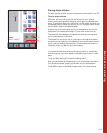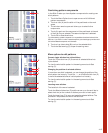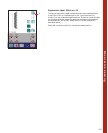
Decorative sewing
4:18
Piecing the quilt top
Cut out the pieces of fabric for your quilt top with a seam allowance
of ¼” (6 mm). Snap on the optional ¼" quilting foot. Sew the pieces
together following the design instructions to piece the quilt top.
The seam allowance of quilts are usually pressed towards the darker
fabric side. Baste the completed quilt top to the batting and backing.
In traditional quilts these three layers of fabric are then sewn together
by hand with small stitches. However, it is quicker and more practical
with your Pfaff creative 2170 e.g. with stitch no. 15 using monofi lament
thread on top and regular or decorative thread in the bobbin.
When the quilting is fi nished simply bind the edges or make it into
cushions, wearable art or other smaller projects.
Stitch-in-the-Ditch
One way to hold the quilt top, batting and backing all together is using
the Stitch-in-the-Ditch method of quilting. Stitching in the ditch means
following the seams in the quilt blocks.
• Set your Pfaff creative 2170 with a straight stitch (no. 1), stitch
length 2.5, center needle position and the IDT engaged.
• Begin by pin basting your quilt through all layers with safety pins
– starting from the middle of your quilt and working out. Place a
pin about every 6 – 8 inches (15 – 20 cm).
• To begin quilting, start sewing from the middle of the quilt and
continue out. Starting from the middle and sewing out will help
keep layers in place. Plan which seams you will actually follow.
This stitching will not only hold the quilt together it will also create
the pattern on the quilt back. You do not need to follow every seam
in the quilt, sew every 3 – 4 inches to keep the quilt in place. Of
course you can sew more to create a more decorative pattern for the
back.
Change to a quilting or jeans needle when sewing through thick quilts.
Test sew to make sure your stitching is proper before you start quilting
your piece.
Tip: Use one of the Antique Quilt stitches No. 311-330, 333-335 instead of the straight
stitch to add interest to your quilt, using monofi lament thread on top and colored thread
in the bobbin. This will make your stitch-in-the-ditch look hand sewn.
Tip 2: Use the optional stitch in the ditch foot for optimal guiding.


















